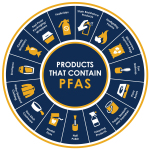New Drinking Water Standards for PFAS

For the first time in decades, the US Environmental Protection Agency (EPA) has added new chemicals to the list of substances regulated by drinking water standards and updated the Superfund law, targeting per- and polyfluoroalkyl substances (PFAS). Since the 1940s, these chemicals have been used to make thousands of domestic and industrial products stain-repellent, nonstick, and waterproof. Because PFAS are slow to degrade in the environment and in humans, they are characterized as “forever chemicals” and accumulate in air, soil, water, and people. Studies have demonstrated that very small amounts of PFAS are carcinogenic and can adversely affect reproductive, endocrine, immune, and developmental systems. Thus, the accumulation of these persistent substances poses a global environmental and public health threat. In accordance with their PFAS Strategic Roadmap for promoting PFAS research, protecting environmental and public health, and holding polluters accountable, the EPA established new drinking water standards for six PFAS and designated two PFAS as hazardous substances under the Comprehensive Environmental Response, Compensation, and Liability Act (CERCLA), also known as Superfund.

